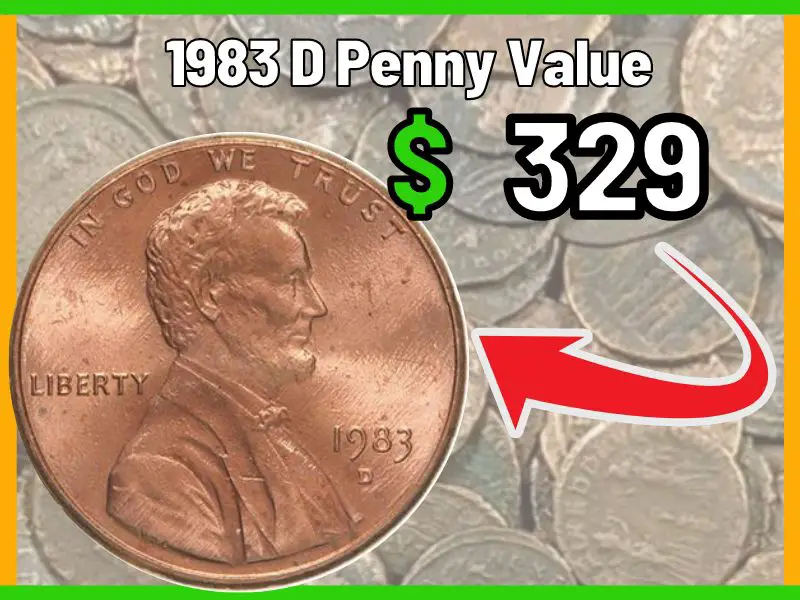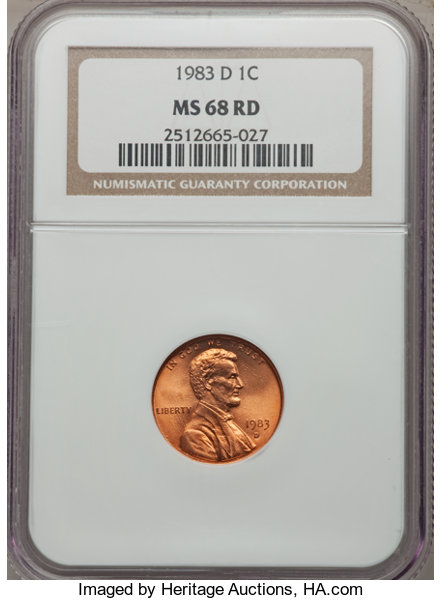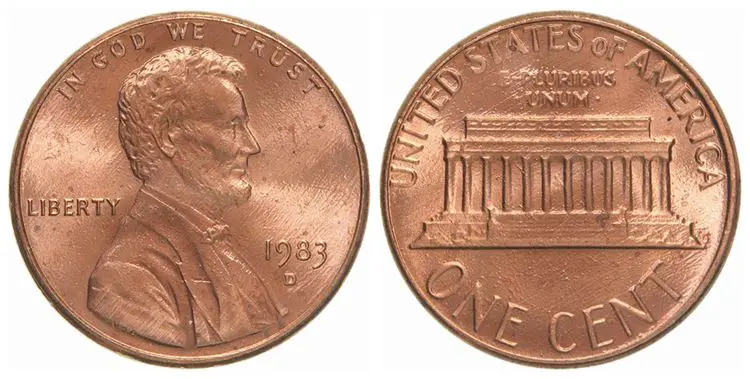
Most 1983 pennies are only worth their face value of $0.01, but The 1983 D penny is worth $0.30 in uncirculated MS 65 grade.
Interestingly, the 1983 pennies were minted during a unique period in United States history. Regardless, The 1983 D penny belongs to the Lincoln memorial series ordinarily and isn’t as valuable as one would expect.
That being said, they have been known to sell for premium prices in uncirculated conditions.
If you’re interested in knowing more about the history of the 1983 D penny and how much a 1983 D Penny is worth, then you should keep on reading this article.
Most Valuable 1983 D Penny
Most vauable 1983 D penny is 1983-D 1C MS68 Red NGC Sold on Dec 7, 2014 for: $329.00

The Lincoln Memorial Penny
The Lincoln memorial penny was introduced in 1959. These coins were in circulation for over 60 years before being replaced by the bicentennial one-cent program in 2008.
The Lincoln penny is a one-cent penny that has been struck by the United States since 1909.
Over the years, it has undergone several design changes, from the original design by Victor Brenner depicting two stalks of durum wheat (hence the nickname wheat pennies) to its current design by Lyndall Bass.
With a diameter of 19.05mm, the Lincoln memorial penny is a plain edge bronze colour coin. It has a composition of 95% copper and 5% tin and zinc.
The coin is a memorial penny used to honour former United States president Abraham Lincoln, the features or detail on the coin were a homage to the late President.
Victor David Brenner designed the coin’s obverse side, making a bust of President Lincoln’s head and above it the inscription “IN GOD WE TRUST.”
On either side of Lincoln’s bust, the word LIBERTY and the coin’s production date with the mintmark right below it.
Flipping the coin over to the reverse side, you’ll find a depiction of the Lincoln Memorial’s front view. Frank Gasparro was responsible for this design. You will also observe the inscriptions “UNITED STATES OF AMERICA”, “E PLURIBUS UNUM”, and “ONE CENT.”
History
The year 1909 marked the centennial year of late President Abraham Lincoln’s birth, and as such, the United States only saw it fitting to honour him by making him the face of the one-cent coin.
The journey to find the perfect design ended up with Victor David Brenner’s design being chosen for the coin’s obverse and reverse in January 1909. As expected, the new coin immediately gained public recognition and was the first widely circulating design of a U.S. president on a coin.
There have been several compositions and design changes over the years, one of which was the “Lincoln Memorial” penny design that was introduced in 1959(to commemorate the 150th anniversary of Lincoln’s birth), replacing Brenner’s wheat ear design on the reverse side of the coin.
This design was last made in 2008 and replaced by the Lincoln Bicentennial One Cent Program.
1983 Lincoln Memorial Penny
The United States minted the 1983 Lincoln memorial pennies with no mint mark as well as the 1983 D pennies and the 1983 S proof pennies.
Most coins belonging to the Lincoln series have copper as a major composition. However, in the United States, mints faced a problem.
The price of copper was skyrocketing, and it became obvious to the United States government that they would be paying more for a coin that cost less. As a result of this, a decision was made in 1981 to change the composition of the Lincoln penny.
The pennies were to be made from a solid zinc core with an outer copper covering, and the composition changed from 95% copper and 5% zinc to 97.5% zinc and 2.5% copper.
In January 1982, all the major mints had changed the composition of the Lincoln penny except for Denver, which later changed theirs in October of the same year.
However, a major mistake later occurred that led to the production of a rare variety. A few pieces were struck by mistake in bronze dated 1983. It turns out that there were a few copper planchets or coin blanks left behind in the coin press. These coins are very rare, and numismatists speculate that some even rarer ones were struck at the Denver Mint.
Features
The 1983 D penny was struck at a time when copper prices rose, and the United States needed to save up on the cost of production.
These coins have a bronze colour like others belonging to the series. Also, it weighs about 2.5 grams.
The Lincoln memorial pennies have been subjected to several design changes over the years.
However, the 1983 pennies maintained the original design from 1959:
- The obverse side has a bust of late President Abraham Lincoln. The inscriptions “IN GOD WE TRUST” are right at the top of the penny, and on either side are the words LIBERTY and the year 1983 with the mintmark below the date.
- On the reverse side is the picture of the Lincoln memorial building. The inscriptions “UNITED STATES OF AMERICA”, and “E PLURIBUS UNUM” are written above the memorial building, and the coin’s denomination “ONE CENT” is just below it.
Mints and Varieties
Most coins in the United States are struck in three major mints; Philadelphia, Denver, and San Francisco, with mintmarks P (or no mint mark), D and S that respectively designates the state they were minted.
With billions of 1983 pennies struck in the United States, there’s nothing particularly rare about the series.
The 1983 D penny is not rare. In fact, The mint at Denver had the second highest mintage for that year, producing 6,467,199,428 coins.
Proofs
A proof is a coin that was struck twice from a new and highly polished die, leaving them with a shiny and very appealing coat. Proof coins are not struck to be circulated, instead, they are produced for collectors. This is why they are the highest quality commemorative coin.
The 1983D proof penny isn’t worth much compared to the 1983 S penny. While the S Penny is valued at $3 in PR 65 condition, the D penny is only worth $0.30 in uncirculated condition.
Errors
There is a rare error variety for the 1983 penny. The mistake at the Denver mint led to the production of a coin made from a planchet that the Numismatic Guaranty Corporation identified as 98% copper and 2% zinc.
This incident happened at a time when the decision was finalized to make zinc the major component of Lincoln pennies following the rise in copper prices. Numismatists generally call it a transitional error.
Some 1983 pennies lack a mintmark and have a doubled die error, causing doubled dates and design elements on the coin’s reverse.
The 1983 penny with no mint mark doubled die error coin is worth around $375 in uncirculated condition with an MS 65 grade, making it one of the most valuable varieties of this series.
How Rare is the 1983 D Penny?
This coin is so common that if you check some loose change you have in your cup holder, you might find a 1983D penny sitting there.
However, there are some cases like the 1983 D error coin that possesses a very unique error. These coins are hard to come across and are very rare and valuable. If you happen to possess such a coin, then consider yourself lucky.
Factors that Affect a Coin’s Rarity
Among collectors, rare coins are extremely valuable compared to other coins from a similar series. They’ve been known to fetch thousands of dollars when sold.
However, not all old coins are rare because some factors influence their rarity in one way or the other. The reality of it is that even most coins that are often considered rarity don’t always tick all the boxes to be true rare coins.
Two factors that affect how rare a coin is considered are the coin’s mintage and collectors’ demand for the said coin.
Mintage
The mintage of a coin refers to the total number of a coin series struck throughout its production year. Coins are usually minted in huge quantities to ensure proper circulation. However, in instances where fewer coins were minted, these coins will not be as abundant as others, making them significantly rarer to find.
Demand
Demand comes into play when there is a limited and fixed number of a particular coin available to collectors. If the demand for the coin is high enough, it will reduce its availability, making it rare.
However, this mostly works for coins with already low mintage. The reason is that if the mintage is high enough, demand will not really matter because of the coin’s abundance.
1983 D Penny Value
The 1983 wheat pennies, as we’ve already mentioned, are not all that valuable. While the history might be a bit interesting, there are so many of them in circulation that they have a face value of only $0.01.
Furthermore, the 1985 D penny is worth more at $0.30 in an MS 65 condition. However, these values are the fixed prices generally attached to the coins. During auctions and sales, they almost always sell for more because of certain factors that affect their values.
Factors that Influence a Coin’s Value
The price at which you can sell your 1983 D penny is determined by how valuable it’s considered. Different coins sell at different prices because of varying attributes, making the value of a coin subject to change.
Grade
Grading is one of the essential factors in determining a coin’s value. The grading system has been developed over the years to get the best scale that better describes the state of a coin and categorizes it.
The Sheldon Scale is the most efficient and popular grading system today. It uses the numbers 1 – 70 to grade and categorize coins and bills. 70 is the highest score a coin can attain on this scale, and it means the coin is in perfect condition with no single scratch damaging its surface.
Another grading system is the American Numismatic Association Scale which puts coins into five categories. In descending order, these categories are Mint State, About Uncirculated, Extremely Fine, Very Fine, Fine, Very Good, Good and About Good.
Rarity
The rarity of the mint is another factor that plays a vital role in how valuable a coin is. Generally, people attach more value to an item the rarer it is or, the harder it is to acquire it. Its rarity makes it special to anyone who manages to get it.
This is why the rarer the coin, the higher its value.
Errors
Errors don’t happen often. Care and attention are given to coins during their production run. This is why in the instance that they occur, such coins are considered rare and are usually valued by numismatists. Thus these coins are in high demand and tend to fetch higher prices when sold at auctions.
In fact, an error coin sells much higher than other coins belonging to a similar series.
Demand
Every market is determined by the consumers that the market is selling to.
When the customer base is inclining toward a particular item, that item’s value steadily increases.
It’s the same thing in the numismatic industry. When there is a high demand for a particular mint, the value of that coin increases. This demand can be due to unique qualities the coin or coins made in that particular mint might possess or its mintage.
Rare coins are very valuable; even coins with errors can be valuable if their demand is high.
Prices
This table contains information on the prices some coins have been sold for on eBay:
Coin Grade |
Price |
1983 D PCGS S 64 RD |
|
1983 D penny PCGS 66 RD |
|
1983 penny clipped planchet error |
Where to Sell Your 1983 D Penny
The numismatist industry is quite large. Many coin enthusiasts and collectors are willing to pay good money to get their hands on your coin, whether it is rare or not.
Currently, there are several places you can find a buyer for your coin. Online auctions on platforms like eBay and Heritage Auction will have collectors bidding for your coin, whereby you can close the deal with the highest bidder.
While waiting on bids might be quite challenging, it’s the most profitable place you sell your coins as it gives you the opportunity to meet buyers from all over the world.
Other useful options are the local coin dealers and pawn shops. On the upside, they are quite useful for low-value coins and some quick cash. However, there is a chance that you might get a lower price for the coin because some might only want to buy it for its attached value.
Also, the above option is useful for assembling a collection because you can get most of the varieties at a lesser cost compared to bidding online.
FAQs
How much should a 1983 D Penny Weigh?
A 1983 penny has a net weight of 2.5 grams.
How do I know if my 1983 D Penny is Copper?
If your Lincoln Memorial penny has a date before 1982, it is made of 95% copper. However, if the date is 1983 or later years, it is made of 97.5% zinc and plated with a thin copper coating.
How can I Tell if I have a 1983 D Penny?
If you want to know if you have a 1983 D penny, then look below the date for the letter D indicating it was minted in Denver.
Wrapping Up
The 1983 D penny belonged to the minted wheat penny series when the original copper composition was replaced by zinc.
Although it’s worth having in any collection for its history alone, at the same time, it’s worth looking out for the unique 1983 D penny error as these coins are extremely rare and valuable.
However, the price you can get on your coin depends on factors such as the condition of the coin, rarity and the platform you sell it.


Joses
Thursday 15th of June 2023
Many Thanks for providing me vital informations related to 1983 D Lincoln memorial penny rarerity